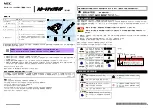
S e n d d o c u m e n t a t i o n c o m m e n t s t o m d s f e e d b a c k - d o c @ c i s c o . c o m
42-28
Cisco MDS 9000 Family CLI Configuration Guide
OL-16184-01, Cisco MDS SAN-OS Release 3.x
Chapter 42 Configuring iSCSI
Configuring iSCSI
QoS
To set the QoS values, follow these steps:
iSCSI Routing Modes
Cisco MDS 9000 Family switches support multiple iSCSI routing modes.
Each mode negotiates different
operational parameters, has different advantages and disadvantages, and is suitable for different usages.
•
Pass-thru mode
In pass-thru mode, the port on the IPS module or MPS 14/2 module converts and forwards read data
frames from the Fibre Channel target to the iSCSI host frame-by-frame without buffering. This
means that one data-in frame received is immediately sent out as one iSCSI data-in PDU.
In the opposite direction, the port on the IPS module or MPS 14/2 module limits the maximum size
of iSCSI write data-out PDU that the iSCSI host can send to the maximum data size that the Fibre
Channel target specifies that it can receive. The result is one iSCSI data-out PDU received sent out
as one Fibre Channel data frame to the Fibre Channel target.
The absence of buffering in both directions leads to an advantage of lower forwarding latency.
However, a small maximum data segment length usually results in lower data transfer performance
from the host because of a higher processing overhead by the host system. Another benefit of this
mode is iSCSI data digest can be enabled. This helps protect the integrity of iSCSI data carried in
the PDU over what TCP checksum offers.
•
Store-and-forward mode (default)
In store-and-forward mode, the port on the IPS module or MPS 14/2 module assembles all the Fibre
Channel data frames of an exchange to build one large iSCSI data-in PDU before forwarding it to
the iSCSI client.
In the opposite direction, the port on the IPS module or MPS 14/2 module does not impose a small
data segment size on the host so the iSCSI host can send an iSCSI data-out PDU of any size (up to
256 KB). The port then waits until the whole iSCSI data-out PDU is received before it converts, or
splits, the PDU, and forwards Fibre Channel frames to the Fibre Channel target.
The advantage of this mode is higher data transfer performance from the host. The disadvantages
are higher transfer latency and that the iSCSI data digest (CRC) cannot be used.
Note
The store-and-forward mode is the default forwarding mode.
•
Cut-through mode
Cut-through mode improves the read operation performance over store-and-forward mode. The port
on the IPS module or MPS 14/2 module achieves this by forwarding each Fibre Channel data-in
frame to the iSCSI host as it is received without waiting for the whole exchange complete. There is
no difference for write data-out operations from store-and-forward mode.
Command
Purpose
Step 1
switch(config-if)#
qos 3
Configures the differentiated services code point (DSCP)
value of 3 to be applied to all outgoing IP packets in this
iSCSI interface. The valid range for the iSCSI DSCP value
is from 0 to 63.
Step 2
switch(config-if)#
no qos 5
Reverts the switch to its factory default (marks all packets
with DSCP value 0).
















































